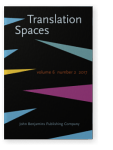Personal issues
“No news is good news?”
The role of feedback in the virtual-team-style translation production network
Professional translation is now predominantly carried out in virtual-team-style production networks where communication between language service providers (LSPs) and freelance translators’ practice is increasingly restricted to computerised methods. Although some literature deals with interactions between different participants in the translation production network, little attention has been paid to the ways in which they exchange feedback on translation products. Using observation and interview methods, this article examines how feedback is perceived and dealt with by freelance translators and LSPs’ project managers. Our results suggest that, although both groups share the value of feedback to some extent, feedback does not always reach translators and the translators are not always aware of the rationale behind it. By drawing on the Job Characteristics Model (JCM) (Hackman and Oldham 1980), which was developed in organisational psychology, we argue that incorporating feedback in the job constructs of freelance translators’ work may help to enhance translators’ motivation.
Article outline
- 1.Introduction
- 2.Feedback in the translation production process: What we (do not) know
- 3.Feedback: Translators’ views
- 3.1Study 1
- 3.2Negative feedback
- 3.3(Lack of) positive feedback and its alternative indicators
- 4.Feedback: PMs’ views
- 4.1Study 2
- 4.2Three sources of feedback
- Positive feedback from end clients
- 4.3Repeated commission and remuneration
- 4.4Tackling the problem of lack of feedback
- 5.Discussion and conclusion
- 5.1No news is not necessarily good news
- 5.2Feedback as a motivation enhancer in job design
- 5.3The issue of feedback in the context of translation studies
- Acknowledgements
- Notes
-
References
This article is currently available as a sample article.
References
References
Abdallah, Kristiina
2010 “
Translators’ Agency in Production Networks.” in
Translators’ Agency, edited by
Kaisa Koskinen and
Tuija Kinnunen, 11–46. Tampere: Tampere University Press.

Abdallah, Kristiina, and Kaisa Koskinen
2007 “
Managing Trust: Translating and the Network Economy.”
Meta: Journal Des Traducteurs 52(4): 673–87.

.

Austermühl, Frank, and Christine Mirwald
2010 “
Images of Translators in Localization Discourse.”
T21N – Translation in Transition 81: 1–44.
[URL].
British Standards Institution
2015 “
Translation Services – Requirements for Translation Services ISO 17100:2015.” London.

Dam, Helle V., and Karen Korning Zethsen
2008 “
Translator Status: A Study of Danish Company Translators.”
The Translator 14(1): 71–96.


Deci, Edward L.
1975 Intrinsic Motivation. New York: Plenum Press.


Drugan, Joanna
2013 Quality in Professional Translation: Assessment and Improvement. London: Bloomsbury Academic.

Dunne, Keiran, and Elena Dunne
Foedisch, Melanie
2017 Managing Translation Projects: Practices and Quality in Production Networks. PhD Thesis, University of Manchester.

Göpferich, Susanne
2009 “
Towards a Model of Translation Competence and its Acquisition: The Longitudinal Study TransComp.” in
Behind the Mind, edited by
Susanne Göpferich,
Inger M. Mees, and
Arnt Lykke Jakobsen, 11–38. Copenhagen: Samfundslitteratur.

Hackman, J. Richard, and Greg R. Oldham
1980 Work Redesign. Reading, Massachusetts: Addison-Wesley.

Jääskeläinen, Riitta
2007 “
The Changing Position of ‘the Translator’ in Research and in Practice.”
Journal of Translation Studies 10(1): 1–15.

Koskinen, Kaisa
2009 “
Going Localised – Getting Recognised. The Inter-Play of the Institutional and the Experienced Status of Translators in the European Commission.”
Hermes – Journal of Language and Communication Studies 421: 93–110.

Lammers, Mark
2011 “
Risk Management in Localization.” in
Translation and Localization Project Management: The Art of the Possible, edited by
Keiran Dunne and
Elena Dunne, 211–32. Amsterdam & Philadelphia: John Benjamins.


LeBlanc, Matthieu
2013 “
Translators on Translation Memory (TM): Results of an Ethnographic Study in Three Translation Services and Agencies.”
Translation & Interpreting 5(2): 1–13.

Neunzig, Wilhelm, and Helena Tanqueiro
2005 “
Teacher Feedback in Online Education for Trainee.”
Meta: Journal Des Traducteurs 50(4).

.

Olohan, Maeve, and Elena Davitti
2015 “
Dynamics of Trusting in Translation Project Management: Leaps of Faith and Balancing Acts.”
Journal of Contemporary Ethnography 46(4):1–26.

.

PACTE
2005 “
Investigating Translation Competence: Conceptual and Methodological Issues.”
Meta: Journal Des Traducteurs 50(2): 609–619.

.

Risku, Hanna, Nicole Rossmanith, Andreas Reichelt, and Lukas Zenk
2013 “
Translation in the Network Economy.” in
Tracks and Treks in Translation Studies: Selected Papers from the EST Congress, Leuven 2010, edited by
Catherine Way, 29–48. Amsterdam & Philadelphia: John Benjamins.

.

Sakamoto, Akiko
2014 Translators Theorising Translation: A Study of Japanese/English Translators’ Accounts of Dispute Situations and Its Implications for Translation Pedagogy. PhD Thesis, University of Leicester.
[URL].
Sakamoto, Akiko
2017 “
Professional Translators’ Theorising Patterns in Comparison with Classroom Discourse on Translation: The Case of Japanese/English Translators in the UK.”
Meta: Journal Des Traducteurs 62(2), 271–288.

.

Sarbin, Theodore
1986 Narrative Psychology: The Storied Nature of Human Conduct. New York: Praeger.

Stoeller, Willem
2011 “
Global Virtual Teams.” in
Translation and Localization Project Management: The Art of the Possible, edited by
Keiran Dunne and
Elena Dunne, 290–317. Amsterdam & Philadelphia: John Benjamins.


Washbourne, Kelly
2014 “
Beyond Error Marking: Written Corrective Feedback for a Dialogic Pedagogy in Translator Training.”
The Interpreter and Translator Trainer 8(2): 240–256.

.

Zouncourides-Lull, Alexandra
Cited by
Cited by 3 other publications
Abdel Latif, Muhammad M. M.
2020.
Researching Professional Translator/Interpreter Experiences and Roles. In
Translator and Interpreter Education Research [
New Frontiers in Translation Studies, ],
► pp. 125 ff.

Ruokonen, Minna & Elin Svahn
This list is based on CrossRef data as of 15 april 2024. Please note that it may not be complete. Sources presented here have been supplied by the respective publishers.
Any errors therein should be reported to them.
